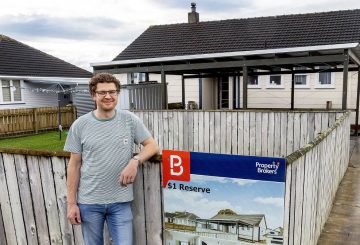수년간 주택시장을 견인한 주요 흐름은 인플레이션 압력의 오랜 감소로 이자율이 크게 떨어져 대출유인은 증가하지만 저축유인은 감소했다는 것이다. 이를 증폭시킨 것은 2008년 GFC와 이후 금리인하 및 해외 양적완화 프로그램이었다.
또한 가구당 소득인원 더 늘어가는 방향으로 변화해왔으며 – 아마도 다른 요인에 의해였을 수도 있다.(이 자체가 집값 상승에 기여) 하지만 아마도 집값 자체가 상승하는 순환적인 증상일 것이다. 사람들은 부동산 마련을 위해 더 많이 일해야 했다.
- 2011
GFC가 열린 지 3년이 지난 지금도 주택시장은 매매와 가격이 가라앉은 채 상당히 조용하다.
경제성은 괜찮지만 첫 주택 구매자는 특별히 적극적이지 않은 반면, 순이동은 저조하고 주거 동의도는 낮다. 이 시기는 건설에 대한 신뢰가 흔들린 시기였고, 이는 주택 부족이라는 지속적인 유산을 남겼는데, 이는 현재도 우리가 다루고 있는 것이다.
새 주거 동의
이 차트는 2011년부터 2021년 3분기까지 새로운 주거 동의의 분기별 변화를 보여줍니다.
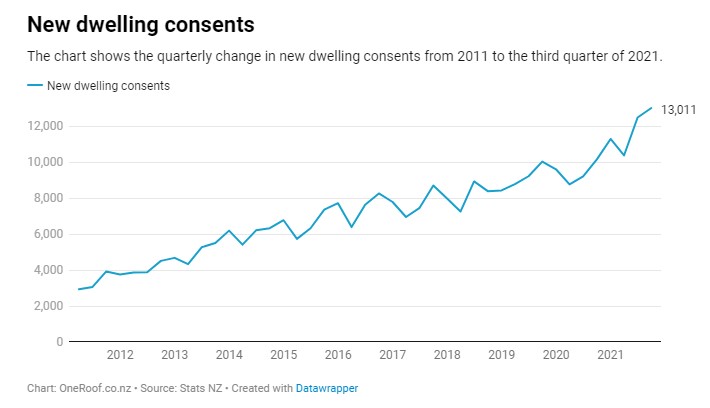
2012
시장은 조금 뜨거워지기 시작하며, 이주는 마이너스가 적고 모기지 금리가 하락합니다.투자자는 여전히 시장에서 확고한 입지를 확보하고 있으며 주거 동의는 바닥에서 벗어나지 만 그다지 많지는 않습니다.
주택 가격 변동
차트는 뉴질랜드의 평균 재산 가치의 변화를 보여줍니다.코어로직에서 제공한 수치입니다.

2013
시장의 “이정표”해: 모기지 금리도 상승했지만 순 이주가 긍정적으로 변하고 인력 참여가 증가하고 있으며 판매와 가격이 가속화되고 있습니다.
투자자는 여전히 활동적이지만 첫 주택 구매자는 여전히 상대적으로 조용합니다. 많은 사람들이 현재 7보다 20% 의 예금을 저축하는 데 필요한 연수입니다.
노동력 참여
이 차트는 2011년부터 2021년 2분기까지 노동 참여의 분기별 변화를 보여줍니다.
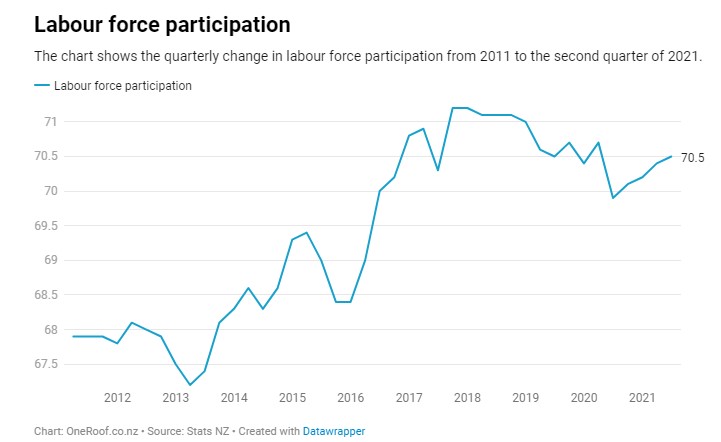
주거 동의가 증가하고 있지만 GFC 흔들림의 유산은 여전히 존재하며 재고 부족은 증가하고 있습니다.
2013년은 또한 준비은행이 낮은 예금 대출 (예치금 20% 미만) 을 10% 로 제한하는 대출 가치 비율 (LVR) 제한을 도입한 해이기도 합니다.
2014
순 마이그레이션은 크게 증가했지만 모기지 금리도 더 높지만 판매량과 가격 상승은 모두 시원합니다.
순 마이그레이션의 변화
이 차트는 2011부터 2021년 3분기까지의 순 마이그레이션의 분기별 변화를 보여줍니다.
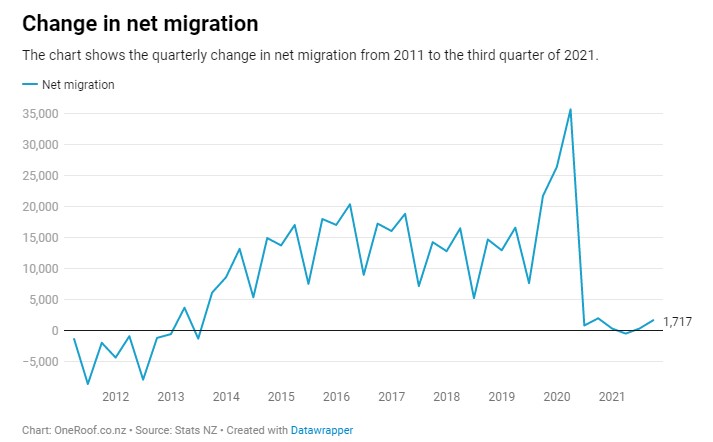
투자자들은 여전히 활동적이지만 LVR 제한은 첫 주택 구매자에게 큰 타격을 입었습니다.
주거 동의의 수는 향상되지만 여전히 과거 표준에 의해 상당히 정복됩니다.
2015
주택 시장의 호황의 해: 매출이 강하고 가격 상승이 두 자릿수로 가속화되고 모기지 금리가 인하되고 순 이주가 새로운 차원에 도달하며 인력 참여는 69% 이상입니다.
첫 주택 구매자는 조금 돌아 왔지만 보증금을 위해 저축하는 데 필요한 연수는 8 세 이상입니다.투자자는 여전히 시장에서 강력한 입지를 확보하고 있습니다.
예금 등반
차트는 매년 소득의 15% 를 저축할 수 있다고 가정하고 2011년 이후 각 분기별 평균 가구 소득과 평균 재산 가치를 기준으로 20% 예치금을 저축하는 데 걸리는 연도의 변화를 보여줍니다.
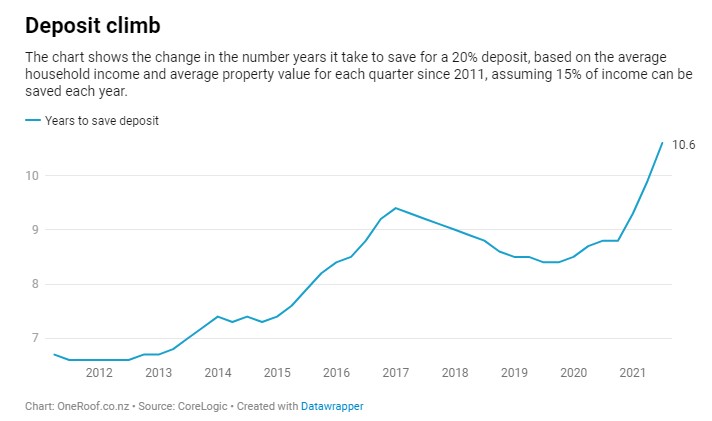
주거 동의가 따라 가면서 주택 부족이 점점 악화되고 있습니다.
내셔널은 구매 후 2년 이내에 투자 목적으로 사용되는 주거용 부동산의 판매에 세금을 부과하는 Brightline 테스트를 도입했습니다.집이 사람의 주된 집인 경우는 예외입니다.
준비 은행은 LVR 규칙을 변경합니다. 오클랜드 투자자는 30% 의 예금이 필요하지만 예금 요건은 다른 모든 사람의 경우 10% 에서 15% 로 점프합니다.
2016
판매 및 가격이 빠르게 상승하면서 시장의 또 다른 성수기입니다.
이주가 진행되고 주거 동의가 높아지고 있지만 여전히 충분하지 않습니다.모기지 금리는 안정적이지만 더 많은 사람들이 인력으로 들어오고 있습니다.
모기지 금리: 하락 및 상승
이 차트는 2011년부터 2021년 3분기까지 2년 고정 금리 모기지의 분기별 변화를 보여줍니다.
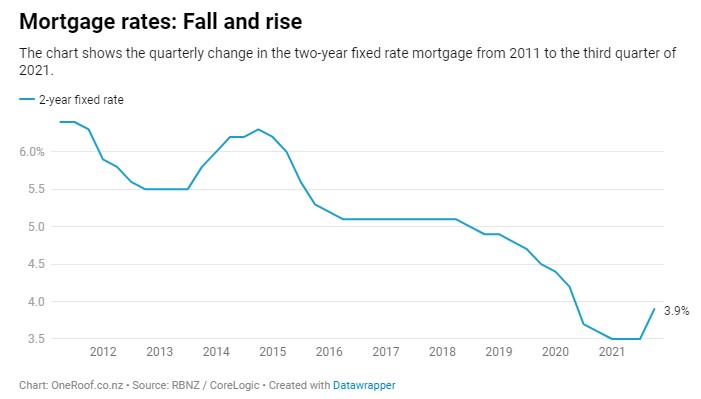
첫 주택 구매자는 정복됩니다. 예금을 위해 저축하는 데 필요한 연수는 9 년이 조금 넘지만 투자자 활동은 여전히 강력합니다.
준비 은행은 LVR을 다시 변경합니다. 투자자는 40% 의 예금이 필요하고 다른 투자자에게는 20% 의 예금이 필요합니다.
2017
투자자들이 뒤로 물러나 전반적인 매출과 가격이 둔화되면서 전환점에 도달했습니다.
예금을 위해 저축하는 데 필요한 연수가 향상되고 첫 주택 구매자가 시장에서 더 큰 점유율을 차지합니다.
첫 주택 구매자 v 투자자
모기지 금리는 안정적이며 이주가 완화되지만 주택 재고에 압력을 가할만큼 여전히 높습니다.
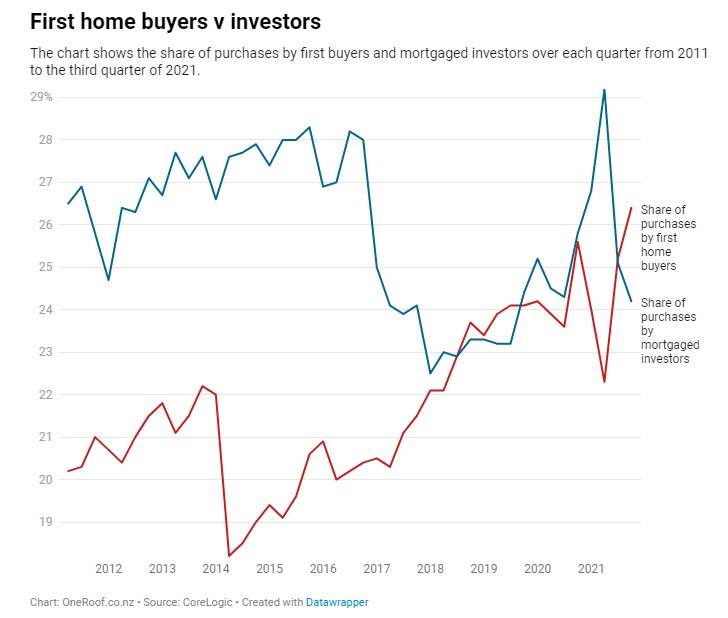
2018
대부분의 지표가 상당히 안정적 인 시장 보유 연도입니다.
판매량의 변화
차트는 2011년부터 올해 3분기까지의 분기별 판매량 변화를 보여줍니다.
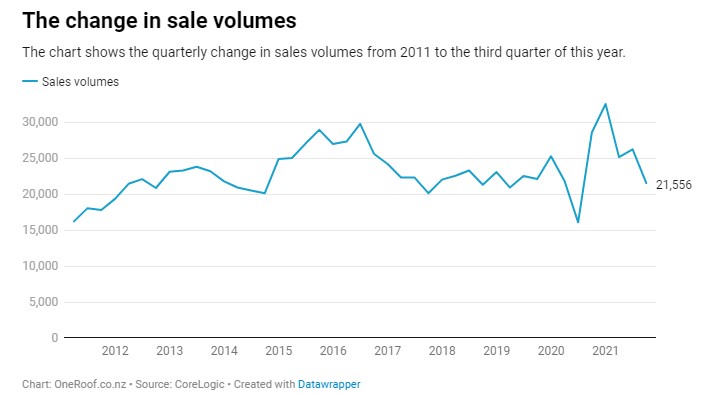
준비 은행은 LVR 제한을 추가로 조정합니다. 투자자에 대한 예금 요건은 40% 에서 35% 로 떨어지고 소유자 점유자의 경우 15% 로 상승합니다.새로운 연합 정부는 Brightline 테스트를 5년으로 연장하고 해외 구매자 금지를 도입했습니다.
2019
시장에서 상당히 안정적인 또 다른 해.준비 은행은 LVR 규칙을 더 느슨하게하고 (투자자 예금은 30% 까지 내려가는 반면, 소유자 점유자의 경우 최대 20%) 첫 주택 구매자는 시장 점유율을 높입니다.
주간 임대료 변경
이 차트는 2011부터 2021년 3분기까지 뉴질랜드의 평균 주간 임대료의 분기 변화를 보여줍니다.
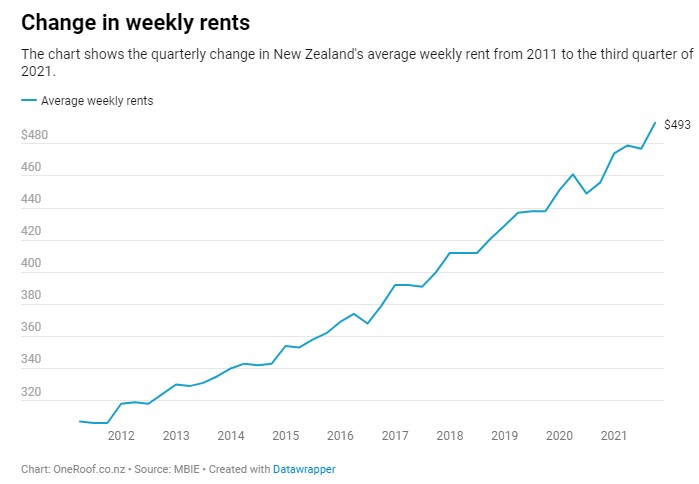
모기지 금리가 하락하는 동안 이주 및 거주 동의가 급증합니다.
정부는 양도 소득세에 대한 제안을 거부하지만 임대 재산 손실에 대한 세금 환급을 도입합니다.
2020
Covid-19는 연초에 타격을 입었고 정부와 준비 은행에 의해 주요 변경 사항이 있습니다. 공식 현금 금리가 0.25% 로 인하되고, LVR 제한이 제거되고, 모기지 지불이 연기 될 수 있으며, 대출 프로그램에 대한 자금 조달이 시작되고 양적 완화는 다시 도입됩니다.
3 월 말에 국가가 폐쇄되고 6 월 말까지 제한이 유지됩니다.주택 시장은 4월과 5월에 하락했지만 6월부터 상승하기 시작합니다.
Healthy Homes 법률은 혼란을 야기하고 비용을 발생시키지만 투자자는 더 작은 예금 요구 사항 (은행 자체 규칙, 약 20%) 을 활용합니다.
순 이주는 붕괴되었지만 주거 동의 수는 확실하고 주택 재고 부족은 마침내 감소하기 시작합니다.
그러나 첫 주택 구매자에게는 이전 피크로 다시 입금하기 위해 저축하는 데 필요한 연수가 많기 때문에 상황이 훨씬 쉬워지지 않습니다.
2021
시장은 호황을 누리고 있지만 2020 년에 도입 된 지원 조치는 서서히 철회됩니다.
준비 은행은 LVR을 복원 및 강화하여 투자자 예금을 40% 로 늘리고 소유자 점유자 요구 사항을 10% 로 떨어 뜨립니다.
또한 7 년 만에 처음으로 OCR을 높이고 양적 완화를 종료하며 부채 대 소득 비율과 같은 새로운 대출 제한을 알립니다.
이자율 변동
차트는 2014년 9월과 2021년 11월 사이의 공식 현금 요율 변화를 보여줍니다.
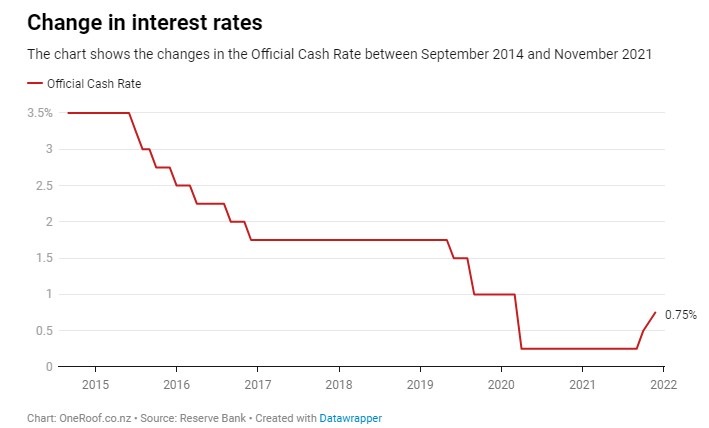
3월에 정부는 경기장을 평평하게 하기 위해 고안된 새로운 주택 정책을 발표했습니다.기존 부동산에 대해 Brightline 테스트가 10 년으로 연장되고 (새 빌드의 경우 여전히 5 개) 모든 신규 구매에 대해이자 공제율이 제거되고 발표 전에 구매 한 제품에 대해 단계적으로 폐지되지만 신규 빌드 구매에는 여전히 적용됩니다.
순 이주는 거의 존재하지 않으며 주택 부족으로 인해 더 큰 움푹 들어간 곳이 있습니다.
-
결론
최근 경제를 지원하기 위해 낮은 모기지 금리가 필요했지만 반대로 뉴질랜드가 더 많은 주택을 더 일찍 지었다면 주택 가격 붐으로 인한 불평등이 완화 될 수 있다는 것입니다.
주택 부족은 부분적으로 GFC 이후 산업이 흔들린 결과 였지만 토지 이용 제한과 자원 관리법에 대한 문제가 남아 있습니다.오클랜드 유니타리 플랜 (Auckland Unitary Plan) 은 그 시장에서 단계적인 변화를 주도하고있는 것으로 보이며, 지진 후 캔터베리의 경험은 의사 결정자들이 신속하게 대응하고 토지를 개방하면 무엇을 할 수 있는지 보여줍니다.최근 자원 동의를 얻기위한 요구 사항의 완화 (예: 같은 구역에 3 층으로 이루어진 최대 3 채의 주택) 도 올바른 방향으로 나아가는 단계 인 것 같습니다.
양도 소득세가 이 모든 것을 바꿨을까요?어쩌면.그러나 뉴질랜드는 이미 Brightline 테스트의 형태로 CGT 형태를 가지고 있습니다.아마도 토지세 또는 재산세가 더 효과적 일 수 있지만, 사람들이 부동산을 사는 것을 막는 것이 아니라 다른 자산에 투자하는 당근도 똑같이 중요합니다.
– 켈빈 데이비슨은 코어로직의 수석 부동산 경제학자입니다.


















































